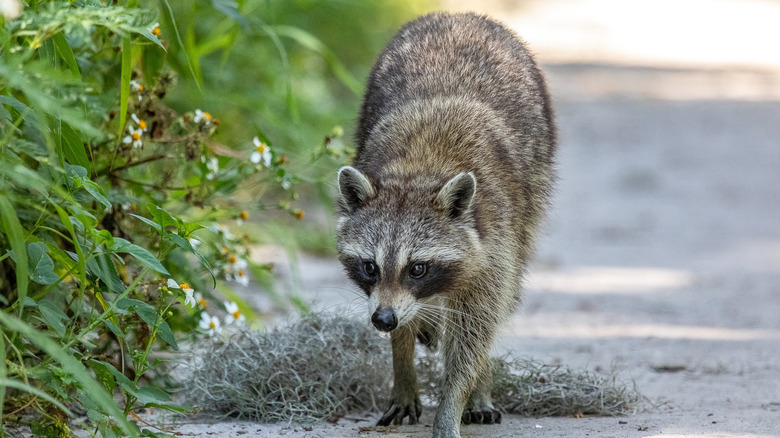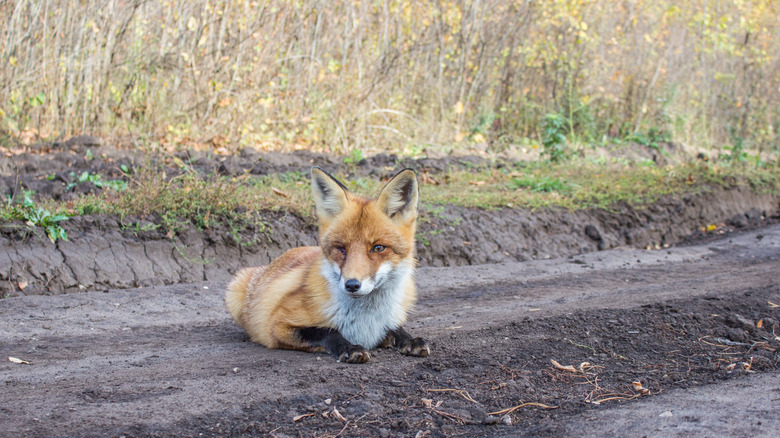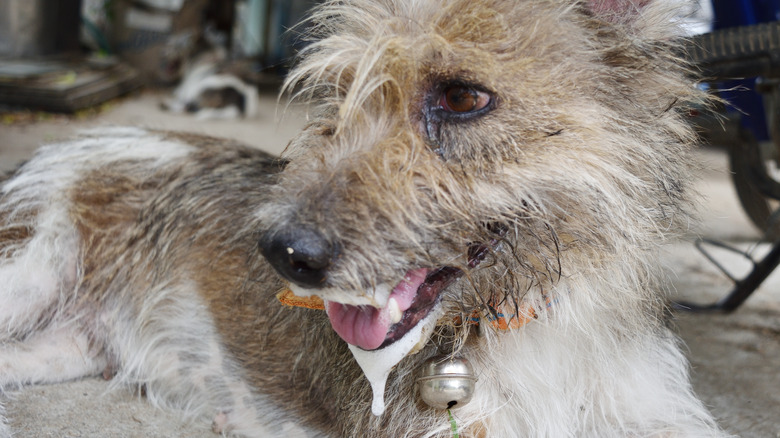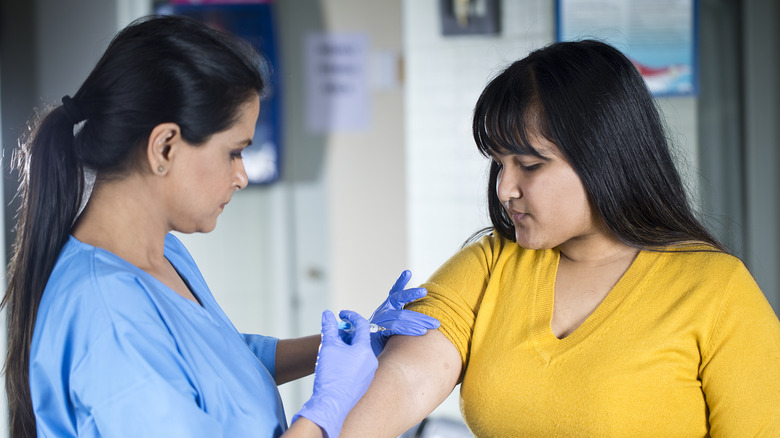Our Expert Reveals How To Avoid Dangerous Encounters With Rabid Wildlife
Spotting wildlife is a major highlight of any outdoor adventure, but it's crucial to remember that some interactions with wild animals can be extremely dangerous. If you run into an animal that is infected with rabies, it could turn into a life-threatening situation for you or your pet. Charles van Rees, Ph.D., Conservation Scientist & Naturalist, and owner of the Gulo in Nature, offered Explore some expert tips on how to avoid rabid wildlife during your next outdoor adventure.
Rabies is a highly contagious viral disease that is spread through saliva when an infected animal bites. It is also possible to catch rabies if the infected saliva comes in contact with mucous membranes like the eyes, nose, or mouth. Rabies is one of the most fatal diseases in the world. Once symptoms begin to show, chances of survival are slim to none. Luckily, rabies infections are preventable with vaccines. Thanks to medical advances, infections have decreased in the United States, although they do still occur in wildlife and unvaccinated pets. Less than ten humans die from rabies each year in the U.S., and according to the Centers for Disease Control (CDC), "around 4,000 animal rabies cases are reported each year, with more than 90% occurring in wildlife like bats, raccoons, skunks, and foxes."
In some parts of the world rabies is more common in domestic animals, so it's important to be aware of — especially if you're traveling internationally with your pets. You should always try your best to avoid all contact with a rabid animal. Knowing whether or not an animal has rabies can be challenging, so Charles van Rees offered Explore some excellent advice on which signs to look for to avoid dangerous encounters.
Watch out for animals with strange movements
Charles van Rees suggests keeping an eye out for animals exhibiting strange behavior to protect yourself and your pets from rabies. "Animals that seem aimless or lost, wandering, not moving with purpose (for example, changing directions often, looking confused) are more indicative of a problem than ones that seem like they are moving around intentionally," he told Explore.
Animals are usually very aware as they move from place to place, as they always have to look out for dangers and predators. If you see a wild animal during your travels, it will usually be darting from place to place, eating, or drinking water. They don't often move around in a meandering way, but rabies can change their normal behavior.
Rabies affects the nervous system of mammals. The virus moves from the point of entry through the spinal column and eventually to the brain, where it causes inflammation. Once it reaches the brain and begins to multiply, animals may move in an unusual way or have trouble walking. They might walk in circles or move erratically. Dr. van Rees told us to look out for "loss of limb function" and other signs of paralysis. This could look like limping or dragging a leg. If you see an animal moving in a way that doesn't look natural, keep your distance and leave the area.
Be weary of unusual animal behaviors
In addition to strange movements and confusion, animals with rabies may exhibit a number of other unusual behaviors. Dr. van Rees suggests spending some time learning about animals so that you'll be able to quickly identify when something seems off. "I strongly advise that people familiarize themselves with local animals and their normal behaviors by reading field guides, watching nature documentaries, or just spending more time outside. This reduces the chances of false alarms or alternatively missing key warning signs," he told Explore.
You'll want to look out for anything out of the ordinary. Dr. van Rees reminded us that, "many larger and more common urban mammals like skunks, raccoons, and coyotes, are largely crepuscular (most active during dawn and dusk hours) or nocturnal (more active at night), so seeing them out in broad daylight, especially on a hot or sunny day, might be a bit out of the ordinary."
Similarly, most wild animals prefer to stay away from people. According to Charles van Rees, they will usually tend to remain around forested areas with plenty of places to hide. He told us that seeing a critter, "totally out in the open might be cause for concern." Rabies can cause animals to lose their normal shy behavior. "Animals may also be less scared of humans than expected, for example approaching or pursuing people. However, in some areas where animals are frequently fed, this might just be a sign that they have learned to associate people with food, which is a different problem and not indicative of a rabies risk," Dr. van Rees said. He also told Explore that signs of aggression are most common in canines like coyotes, foxes, and dogs. Other animals may simply appear confused.
Don't approach animals with a sickly appearance
Watching for unusual behaviors is a great way to keep yourself safe from wildlife that might be affected with rabies, but sometimes you'll be able to quickly notice that an animal is physically unwell. One of the most notorious symptoms of rabies is "foaming at the mouth," which is caused by an increase in saliva and muscle spasms. Even if you don't see foam, excessive drooling and spit around the mouth can indicate rabies. According to Dr. Van Rees, an animal with rabies might also have, "a very unkept, mangy appearance." He advised that you should look out for signs like "matting of fur around the eyes or nose."
Rabies isn't the only thing that can cause an animal to look sick, and you may feel tempted to try and help a sick or hurt creature during your travels. Although it's wonderful to feel compassionate towards animals, it's best to leave them alone. "Many animals are significantly endangered by coming into contact with people, even if those people mean them no harm," Dr. Van Rees told Explore. Besides, even if an animal isn't infected with rabies, they could be extra aggressive because they're sick.
Educate yourself on what kind of wildlife can carry rabies when you travel
Rabies is one of the major health risks to be aware of on any adventure in which you might encounter wildlife. If you're planning on spending some time in nature, or visiting an international destination, it's a good idea to research the rabies risks you may encounter. Being well-informed can help you feel safer while traveling. According to Charles van Rees, you only need to worry about mammals. "First, it's worth readers knowing that only mammals can be infected with rabies, so animals like birds, frogs, lizards, and so-on cannot be 'rabid'," he told Explore in an exclusive interview.
In the United States, it is rare for dogs to be infected with rabies because most pets receive preventative vaccinations during the first few months of their lives. Most vets also recommend booster shots every one to three years. In other parts of the world, it is still common for pets (particularly dogs) to carry rabies. According to the CDC, rabies kills around 70,000 people per year globally. Around 99% of those cases are caused by bites or scratches from dogs in places other than the United States, which makes dogs some of the deadliest animals in the world.
Several countries, primarily in Europe, are considered rabies-free, but bats can carry rabies anywhere in the world. They're one of the smallest lethal creatures on the planet. Even if you are traveling in a country that has been designated rabies-free, you should treat any encounter with a bat as a potential exposure, according to the UK Health Security Agency.
What to do if you encounter a rabid animal
According to Dr. Van Rees, the most important thing you can do if you encounter an animal that shows any signs of rabies is keep your distance. "This is a great rule with any wildlife in any condition; keeping your distance not only keeps you safe, but it keeps wildlife safe from you," he said. When you're out in nature with pets, make sure to keep them on a leash, and work on training them not to go after wild animals. It may seem harmless to let your dog run after a squirrel every now and then, but if they run after a rabid raccoon, it could be a tragic situation. At best, it could cut your trip short and require an emergency trip to the vet for a rabies booster.
After encountering an animal that you suspect might have rabies, Dr. Van Rees suggests that you "find a way to get away without turning your back or running from the animal. Seek to create distance between you and the animal; if you're with a small pet or child, pick them up to keep them safe." Once you are in a safe place, "call the local wildlife or animal control authority, or law enforcement, so that they can address the threat," he added.
If you or your pet are bitten or scratched by an animal with rabies, it is important to seek medical attention right away. "Don't wait," Dr. Van Rees warned Explore readers. Although rabies is dangerous, the emergency treatments can be very successful at preventing a life-threatening infection. The earlier you receive treatment, the more effective it will be.





